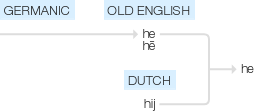He
Old English he, hē, of Germanic origin; related to Dutch hij .
wiktionary
From Middle English he, from Old English hē, from Proto-West Germanic *hiʀ, from Proto-Germanic *hiz(“this, this one”).
Transliteration of various Semitic letters, such as Phoenician 𐤄 (h), Hebrew ה (h), Classical Syriac ܗ (h, “hē”), and Old South Arabian 𐩠 (h).
he
etymonline
he (pron.)
Old English he, pronoun of the third person (see paradigm of Old English third person pronoun below), from Proto-Germanic *hi- (source also of Old Saxon, Old Frisian, Middle Dutch he, hi, Dutch hy, Old High German he), from PIE *ki-, variant of root *ko-, the "this, here" (as opposed to "that, there") root, and thus the source of the third person pronouns in Old English. The feminine, hio, was replaced in early Middle English by forms from other stems (see she), while the h- wore off Old English neuter hit to make modern it. The Proto-Germanic root also is the source of the first element in German heute "today," literally "the day" (compare Old English heodæg).
The paradigm in Old English was: MASCULINE SINGULAR: he (nominative), hine (accusative), his (genitive), him (dative); FEMININE SINGULAR: heo, hio (nom.), hie, hi (acc.), hire (gen. and dat.); NEUTER SINGULAR: hit (nom. and acc.), his (gen.), him (dat.); PLURAL: (all genders) hie, hi (nom. and acc.), hira, heora (gen.), him, heom (dat.).
Pleonastic use with the noun ("Mistah Kurtz, he dead") is attested from late Old English. With animal words, meaning "male" (he-goat, etc.) from c. 1300.
